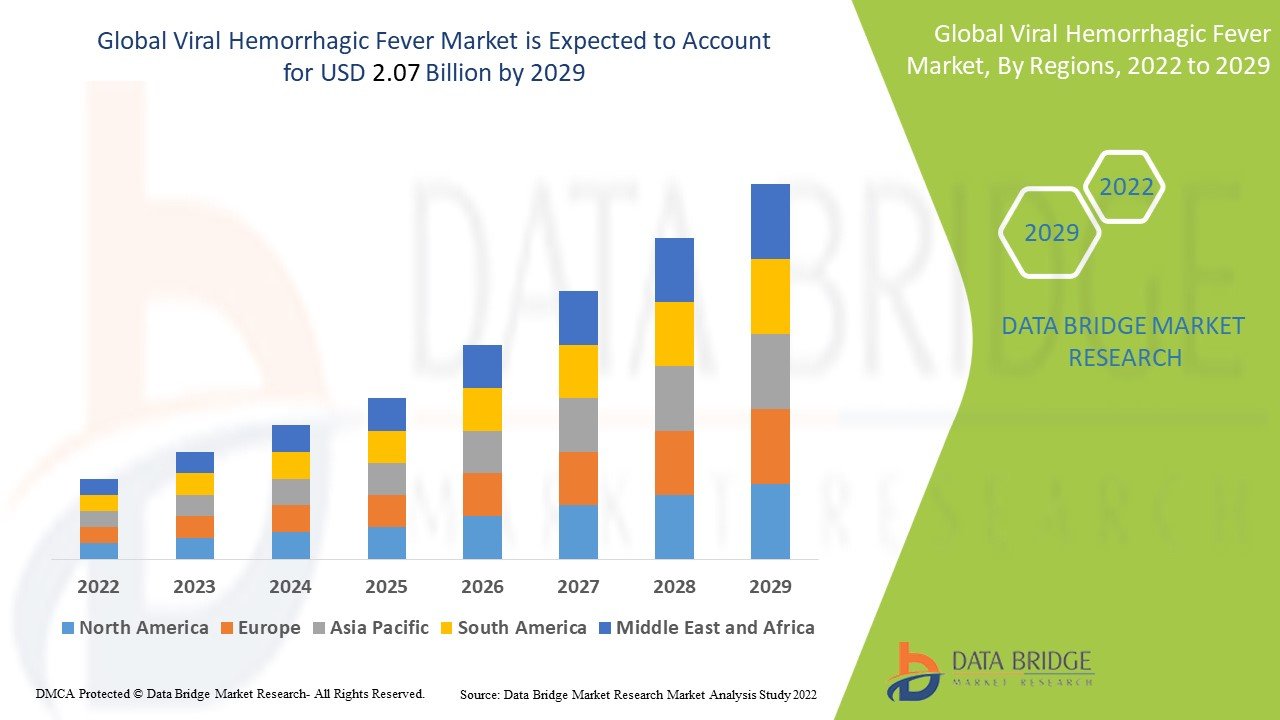Introduction
Viral Hemorrhagic Fevers (VHFs) are a group of severe and life-threatening diseases caused by viruses such as Ebola, Lassa fever, Dengue, and Marburg. These viruses can lead to severe bleeding, organ failure, and high mortality rates. The growing prevalence of VHFs has intensified the demand for diagnostics, vaccines, and treatment solutions.
Browse for More Details: https://www.databridgemarketresearch.com/reports/global-viral-hemorrhagic-fever-market
The Viral Hemorrhagic Fever Market is witnessing significant growth due to increasing outbreaks, rising awareness, and advancements in medical research. The market is driven by government initiatives, funding from health organizations, and biotechnology innovations.
This article explores the evolution of the market, emerging trends, factors influencing growth, market share analysis, and segmentation of the industry.
The Evolution of the Viral Hemorrhagic Fever Market
The market for VHFs has evolved significantly over the past few decades. Initially, research and development were limited, with only a few outbreaks recorded worldwide. The lack of awareness and funding slowed the development of vaccines and treatments.
In the early 2000s, high-profile outbreaks such as the Ebola epidemic in West Africa brought global attention to the severity of VHFs. Governments and international health organizations started investing heavily in research, leading to the development of new diagnostic tools and vaccines.
Pharmaceutical companies have accelerated their efforts in producing antiviral drugs, and new treatment approaches are being tested to combat these deadly infections. Biotechnology firms are also playing a crucial role in developing cutting-edge therapies, making the market more competitive.
Market Trends
The market is witnessing rapid changes due to technological advancements, increased funding, and improved healthcare infrastructure. Some of the major trends shaping the industry include:
- Rise in R&D Investments: Pharmaceutical and biotech companies are investing heavily in vaccine development, early diagnosis tools, and effective treatment options.
- Government Initiatives and Funding: Governments across the world are allocating funds for research and preparedness programs. Organizations such as the WHO and CDC are providing financial and technical support.
- Increased Awareness and Surveillance: Public health agencies are conducting awareness campaigns and improving disease surveillance systems to detect and control outbreaks at an early stage.
- Advancements in Biotechnology: Gene therapy, monoclonal antibodies, and RNA-based treatments are being explored to enhance treatment effectiveness.
- Growing Collaborations and Partnerships: Pharmaceutical firms, research institutions, and governments are collaborating to accelerate drug development and vaccine production.
Factors Driving Market Growth
Several factors are fueling the growth of the Viral Hemorrhagic Fever Market, including:
- Rising Number of Outbreaks: The increasing frequency of outbreaks worldwide has heightened the need for effective diagnostic and treatment options.
- Advancements in Medical Technology: Cutting-edge diagnostic tools, genetic research, and vaccine development have boosted the market.
- Increased Global Travel and Urbanization: The spread of infectious diseases has increased due to global travel, making early detection and prevention essential.
- Government Support and Regulations: Many governments have established policies and guidelines to improve disease management and invest in public health infrastructure.
- Growing Biopharmaceutical Industry: The demand for antiviral drugs and vaccines has led to increased investments in pharmaceutical companies and research institutions.
Market Share Analysis
The market is dominated by key players involved in vaccine production, diagnostics, and pharmaceutical solutions. Some of the major companies contributing to the market include:
- Johnson & Johnson
- Gilead Sciences
- Moderna Inc.
- GlaxoSmithKline (GSK)
- Pfizer Inc.
- Roche Diagnostics
These companies are investing in research and development to introduce new treatment solutions, increasing their market share. The competition is intense, with companies focusing on innovative product launches and strategic collaborations.
Market Demand
The demand for viral hemorrhagic fever treatment is rising due to:
- Increased Hospitalization Rates: More patients require critical care and hospitalization, creating a demand for advanced treatment options.
- Shortage of Effective Treatment Solutions: Many VHFs lack approved antiviral drugs, increasing the demand for novel therapies.
- Expansion of Healthcare Infrastructure: The development of healthcare facilities and research centers worldwide is driving the demand for diagnostics and vaccines.
- Public Awareness Campaigns: Governments and health organizations are focusing on education and preventive measures, increasing the adoption of vaccines and diagnostic tests.
Market Segmentation
The Viral Hemorrhagic Fever Market is segmented based on:
1. By Type of Virus
- Arenaviridae (Lassa Fever, Argentine Hemorrhagic Fever)
- Filoviridae (Ebola, Marburg Virus)
- Bunyaviridae (Crimean-Congo Hemorrhagic Fever, Rift Valley Fever)
- Flaviviridae (Dengue, Yellow Fever, Zika Virus)
2. By Treatment Type
- Antiviral Medications
- Vaccines
- Supportive Therapy (IV Fluids, Oxygen, Blood Transfusion)
3. By End User
- Hospitals & Clinics
- Research Institutes
- Government & Public Health Organizations
4. By Region
- North America (United States, Canada)
- Europe (Germany, UK, France)
- Asia-Pacific (China, Japan, India)
- Latin America (Brazil, Mexico)
- Middle East & Africa (South Africa, GCC Countries)
Conclusion
The Viral Hemorrhagic Fever Market is expanding due to increasing outbreaks, technological advancements, and rising investments in healthcare infrastructure. With continued research and development, the market is expected to witness significant growth in the coming years.
Pharmaceutical and biotechnology companies, along with government agencies, are actively working towards better diagnostic tools, effective treatments, and vaccines to combat these deadly infections. The industry is highly competitive, with companies investing in innovation to gain a competitive edge.
As global health awareness rises and disease surveillance improves, the demand for VHFs diagnostics, vaccines, and treatments will continue to grow, making this a crucial sector in the healthcare industry.



